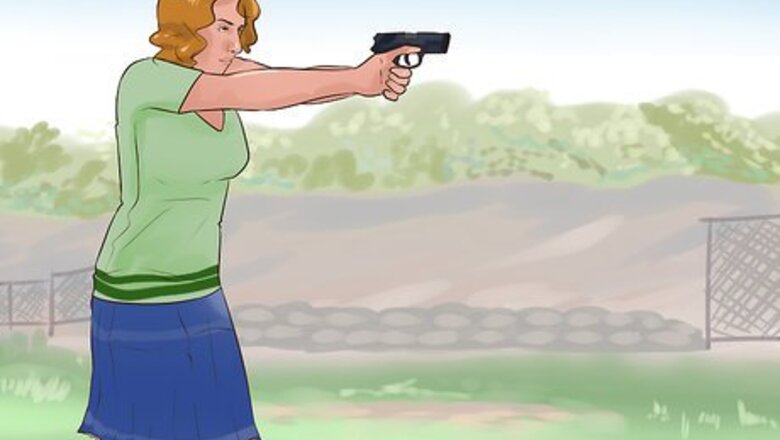
views
Firing Accurately with a Pistol

Choose a comfortable pistol firing stance. Firing a pistol accurately starts at your feet. Three are three common stances to choose from when firing a pistol accurately. The right stance for you will depend on your level of comfort, your natural firing position, and preference. The isosceles stance involves positioning your feet evenly about shoulder width apart. The weaver stance uses staggered footing, with the foot on your dominant side set back and your lead foot pointed at the target. The fighting stance bridges the gap between the two, placing your feet shoulder width apart and with your dominant side foot only slightly behind your lead foot. In all three positions, the shooter extends the weapon directly out in front of them. Each position has advantages and disadvantages and it’s recommended that beginner shooters try all three to see which feels the most stable for them.
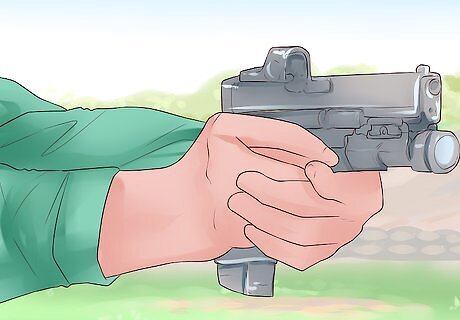
Get a good grip. Always use two hands when firing a pistol. Your dominant hand should seat high on the handle of the pistol and you should extend your trigger finger along the side of the weapon. Your non-dominant hand should be slightly lower, wrapping around the handle. Do not place your non dominant hand on the bottom of the pistol, as it will prevent you from ejecting a spent magazine when reloading quickly. The web of your dominant hand (span of skin between your thumb and index finger) should be aligned with the wrist to properly absorb recoil. Squeeze the pistol in your hands firmly, but not too tight. If your knuckles turn white, you are squeezing the pistol too hard.
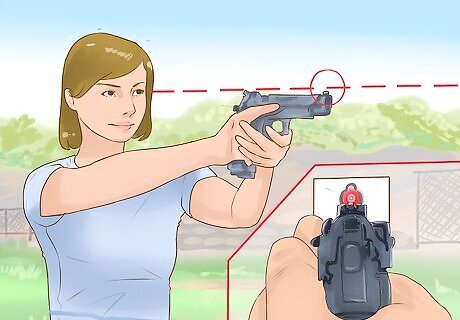
Find good sight picture. Most pistols come equipped with a front sight tip and rear sight aperture. The front sight tip is the small post sticking up from the end of the barrel of the gun. When you raise the pistol, focus on the front sight tip and ensure it is centered on your target. Having the front sight tip centered on the target is referred to as getting proper “sight picture.” In close quarters situations, acquiring sight picture is often sufficient to accurately engage a target. Sight picture is imperative to accuracy. A common saying in military training is, “in a gun fight, you have the rest of your life to acquire good sight picture.”
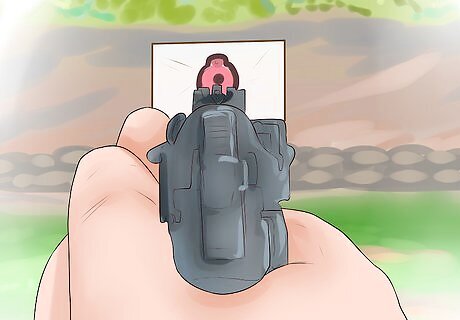
Establish sight alignment. If your target is further than a few feet away, you will need to couple sight picture with proper sight alignment. Sight alignment occurs when you position the weapon so the front sight tip is centered between the two posts that make up the rear sight aperture near the back of the weapon. When the front sight tip and rear sight aperture are aligned, this creates sight alignment, meaning the weapon is level and not angled in any way. The front sight tip and rear sight aperture should be of even height, meaning neither appears to sit higher than the other in your perspective. With good sight alignment and sight picture, the target should be blurry behind the front sight tip, which is centered in your vision between the two posts of the rear sight aperture.
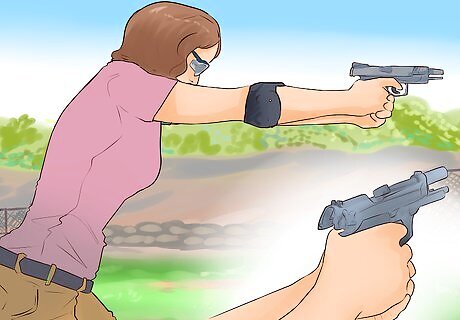
Manage the pistol’s recoil. As you squeeze the trigger, the firing pin will strike the back of the round, igniting the gun powder and sending the round down range. This contained explosion is directed out the barrel, which in turn tries to push the weapon backwards. This counter force when firing a weapon is called recoil. Manage recoil by combing a proper firing stance with a good grip. As soon as you fire the weapon, quickly regaining sight picture and alignment will eliminate issues caused by recoil. The design of the weapon, the type of ammunition, and the caliber of the weapon can all effect the amount of recoil your pistol produces.

Follow through with your shots. After firing a round, do not immediately re-holster your weapon or move to acquire a new target. Instead focus on the target even after releasing the round. This will prevent you from accidentally sending a round off course by moving before the round has left the barrel. Even a tiny amount of movement can send a round off target at a distance. Wait a second before moving on to a new target or lowering your weapon.
Firing Accurately with a Long Gun
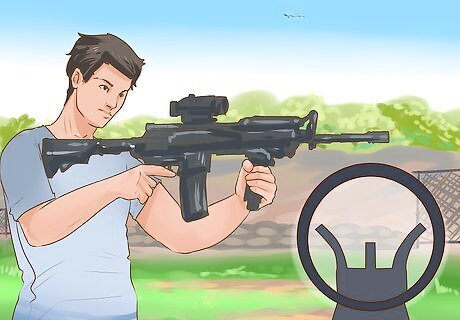
Get sight picture and alignment with iron sights. Iron sights on a rifle work in the same way the front sight tip and rear sight aperture work on a pistol. Ensure the front sight tip is centered on the target, and is centered in your view between the two tips of the rear sight aperture. This ensures your weapon is even and level. Rifle sight tips and rear sight aperture are often adjustable, as is uncommon with pistols. This allows you to adjust your sights to improve your accuracy. You should sight in your rifle to make sure it is aimed exactly where you intend. Sight picture and alignment also pertains to firing shotguns.

Acquire your target using a scope. Rifle scopes magnify your target to make it easier to aim at a specific point. Using a rifle scope can dramatically increase your accuracy over long distances as long as the weapon is properly sighted in and you practice solid shooting fundamentals. Establish sight picture in a rifle scope by centering the reticle of the scope on your target, and ensuring the circle you look through at the end of the scope is centered in your view through it. You can purchase scopes with varying levels of magnification based on the distance you intend to shoot. The higher the magnification of the scope, the more difficult it can be to establish proper sight picture.
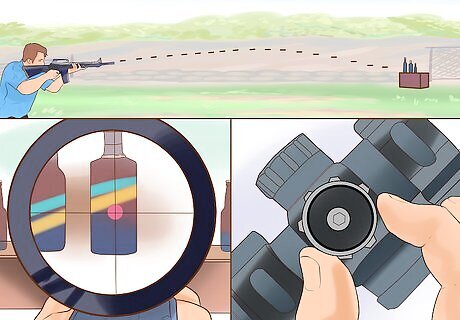
Adjust elevation for accuracy. You can adjust the elevation on a rifle scope by twisting the elevation knob. While there are many different brands of scopes, the elevation knob is commonly on the top of the scope. Turning the knob to the right will raise the point your round impacts the target. Turning the knob to the left will lower it. If you are firing at a further distance than the weapon is zeroed for, you will need to increase the elevation in the scope to compensate for the round dropping in height as it travels between your weapon and the target. The elevation knob adjusts where your rounds will impact on the vertical axis (up and down).
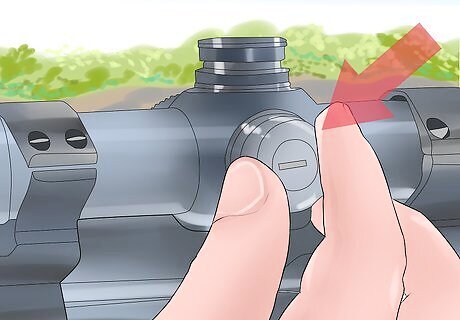
Change windage based on your environment. The windage knob is often located on the right side of a rifle scope and adjusts the impact point of the round on the horizontal axis (from left to right). If you are firing into a strong wind, you should adjust the windage into the wind to compensate for how the wind will push the round as it travels to the target. Turning the knob to the right will bring the rounds further to the right and vice versa. Depending on the rifle, ammunition, scope and distance from the target, adjustments to your windage will move the round different amounts for each click of the knob. Look at the area between you and your target for signs of strong winds, then adjust your windage to suit.

Support the weapon properly. Always make sure the buttstock of the rifle is seated firmly in your shoulder. Place your dominant hand high on the pistol grip of the rifle or the buttstock where you can comfortable reach the trigger. Use your other hand to support the weapon. Whenever possible, use a bipod, sandbag or other stable object to rest the rifle on to prevent it from moving. If you are firing from a standing position, wear a tight sling that helps keep the rifle planted in your shoulder. Moving the barrel of the weapon even slightly can result in missing your target by feet over a large distance. Try to use your bones to support the weapon instead of muscle. Fire from a seated or prone position when possible with your elbows resting on your knees or the ground to eliminate wobble created by tiring muscles. Shoulder a shotgun in the same way you would shoulder a rifle.
Practicing the Fundamentals of Shooting
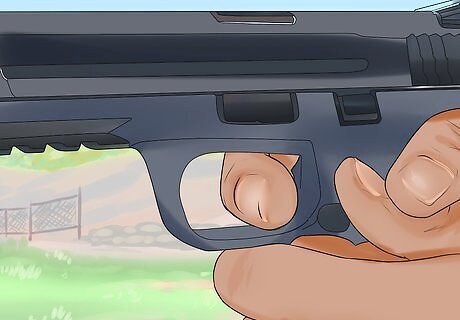
Utilize proper trigger control. Despite the common phrase “pull the trigger,” you should never pull a trigger on a rifle or pistol. Always squeeze the trigger with slow, steady pressure. Pulling a trigger can alter the direction the weapon is pointed slightly, and although the shift may be difficult to notice as you fire, it will be evident when your round fails to impact where you intended. Try counting to three or five in your head as you slowly squeeze the trigger, then leave the trigger pulled for a one count before releasing it. Pulling a trigger can cause the weapon to jerk slightly, while a controlled squeeze allows you to keep the weapon on target. Act as though you are attempting to close your fist through the weapon’s handle to squeeze the trigger instead of pulling it.
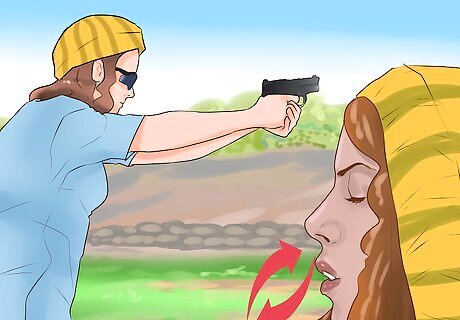
Practice breath control. As you breath, your lungs fill with air and then expel it, which can also affect your ability to keep the weapon on target. To combat this, you should always fire during the natural pause between exhaling and inhaling. Time your shot so you squeeze the trigger after you exhale, then don’t breath in again until the round has been fired. You move the weapon slightly as you breath, and although it may be difficult to notice, it can have a dramatic effect on your accuracy downrange. Maintaining calm, steady breathing is important to ensuring you fire accurately, so practice firing during the natural pause between breaths instead of holding your breath as you fire.
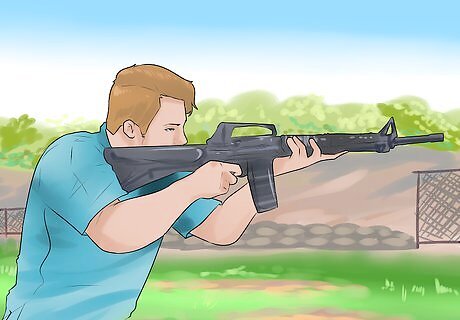
Start with your natural point of aim. When you first raise your weapon and look through the sights, it is often not quite on target. This is your natural point of aim, and it’s where your body naturally wants to point the weapon. Don’t fight this natural point of aim, and instead, shift your entire body so your body wants to point the weapon directly as the target. Fighting against the natural point of aim can tire your muscles out and make it difficult to fire accurately. If you find your natural point of aim is off to the left of the target, lower the weapon and move your feet to turn your whole body a bit to the right, then raise the weapon again. Finding your natural point of aim, then centering it on the target will make firing accurately much easier.
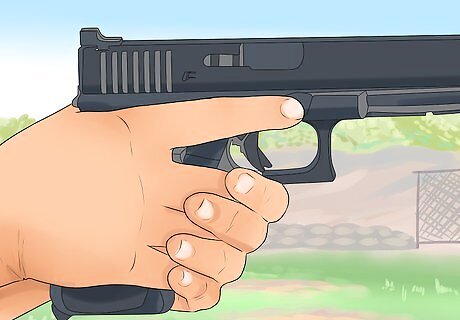
Understand the rules of firearm safety. There are four common rules of firearm safety that you should exercise any time you are around firearms. These rules were established to keep you and those around you safe. These rules are taught and exercised at firearm ranges, in law enforcement and the military, and work for all weapon applications. The four rules of firearm safety are: Treat every weapon as if it were loaded. Never point a weapon at anything you do not intend to shoot. Keep your finger straight and off the trigger until you are ready to fire. Keep the weapon on safe until you are ready to fire.
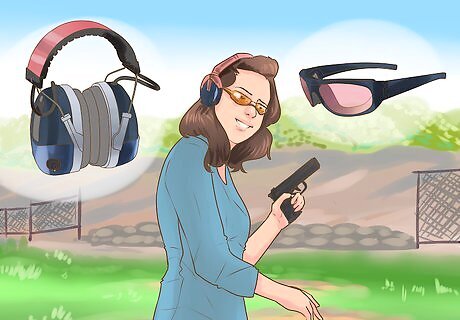
Always wear the appropriate safety gear. Whenever you are firing a weapon, it’s important that you wear the appropriate eye and ear protection. Eye protection will prevent expelled shells from hitting you in the eyes and protect you if the weapon were to suffer a malfunction. Ear protection will prevent you from suffering hearing loss or ruptured ear drums as a result of the loud sounds of gunfire. Look for ballistic rated or shatterproof eye protection. You can purchase ear protection that goes over the ear or inside it; either are acceptable.




















Comments
0 comment